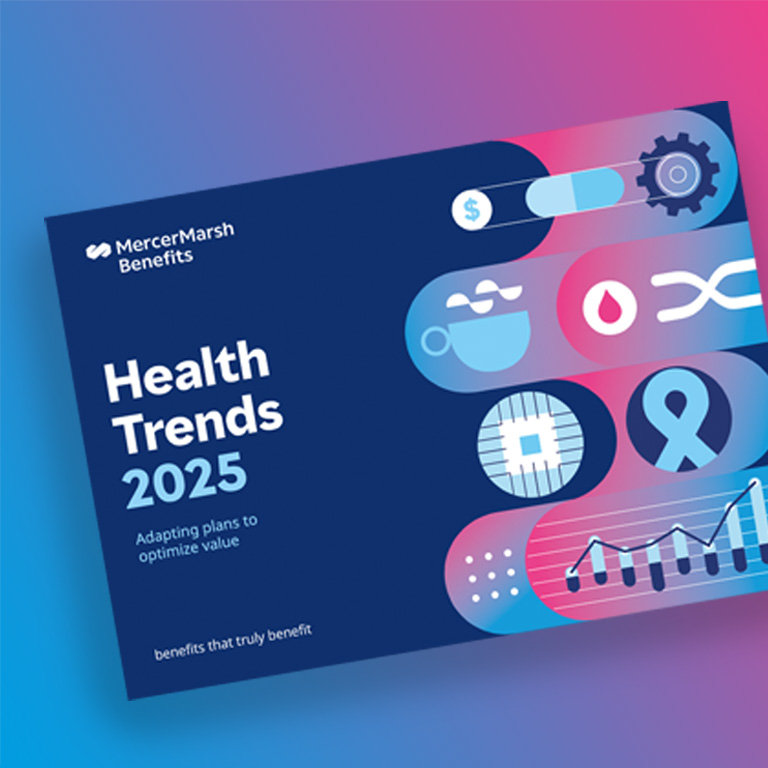
Ricardo Almeida
Managing Director, Latin America and the Caribbean, Mercer Marsh Benefits
This is particularly challenging given current economic circumstances as organisations struggle to address the impact of inflation, and more specifically rising medical costs. To do so, employers will have to articulate and execute on well-planned cost-optimisation strategies, consider new ways to advance holistic wellbeing and put greater focus on vulnerable populations, such as low-paid employees.
Uncertainty has been the name of the game for benefits specialists over the past few years. Although medical plan trend (the annual rate of increase in per-person claims) has stabilised since the pandemic, it’s still higher than pre-pandemic levels according to Health Trends 2024 research. At the same time, benefits managers are trying to cope with a polycrisis of issues impacting benefits — from climate events to misinformation to ongoing economic uncertainty.
As a result of these economic challenges, employees are facing multiple new hardships, from rising interest rates to unaffordable housing. In response, employers are trying to get ahead of what significant inflation means for designing and financing their employee benefits and wellbeing plans.
Industry concern is high — governance and financial risks featured prominently in our People Risk 2022 research. Among the 25 risks reviewed in our report, three such risks made the top 10: administration/fiduciary; the increasing cost of health, risk protection and wellbeing benefits; and benefits, policy and reward decision-making and accountability.
In light of ongoing inflation, a key concern among employers is whether the current environment will have a significant impact on medical and insured benefits.
Although employer costs for employee medical coverage are affected by inflation (due to increases in the per-unit costs for medical services and supplies), other factors must also be considered for budgeting and rate-setting. These include:
The upshot is that insurers, advisors and plan sponsors alike face numerous difficult issues when trying to anticipate 2024 claims. Will compensation increases continue for healthcare workers who are in short supply? Will demand for new treatment regimens further drive up claims, or will new developments in areas like at-home patient monitoring and digital triage make managing conditions more cost effective?
According to publicly available economy-wide data (not specifically employer-sponsored), medical cost inflation is now as pronounced as — or even exceeds — general inflation in many countries.
It is our view that inflation will likely have an impact on 2024 renewals in most markets. Claims experience and the demography of covered individuals will also be strong influencers of employer premium increases.
Because forecasting medical plan costs is quite complex in the US, it’s common for US employers to finalise the following year’s benefits designs six months before the plan year start date. In comparison, employers in some countries outside the US only finalise their designs a month in advance. Given the current dynamic situation, many insurers will be reluctant to release renewal terms far in advance. However, plan sponsors are advised to get ahead of renewals by developing cost-containment strategies as soon as possible and creating plans to manage change — especially intrusive changes — within the organisation.
In our opinion, the next few years will be challenging for those negotiating medical insurance premium rates. Adding to the complexity of this task is the need to balance cost prudence against stiff competition for skills. In the pandemic era, there has been an increased appreciation for the critical role of health and risk protection benefits in protecting employees and businesses. Cutting such benefits — for example, by increasing claims or premium cost-sharing — could disengage key talent. In light of this, advisors and plan sponsors should engage in dialogue early to:
Our Global Talent Trends research shows that one-third of employees would forgo a pay increase in return for additional health and wellbeing benefits for themselves or their families. This raises a number of possibilities and questions: Can you, as an employer, beat inflation with a well-rounded and compelling employee value proposition? If your organisation is facing a long-term labour shortage, will compounding year-on-year cash increases be sustainable, or will it be better to divert a portion of this expenditure to health and wellbeing benefits that will position you as a caring employer?
Employers wary of the future implications of inflation on enhanced defined-benefit medical plans have a unique opportunity to think and act creatively. One key approach is to use the common inflation-control technique of product substitution. Especially in the case of new types of benefits, such as the wellbeing benefits expected by today’s workforce, there are opportunities to prioritise options that are less exposed to inflation (when compared to traditional medical insurance plans). These options include: defined-contribution health and wellbeing spending accounts, credits toward the purchase of preventive care or lifestyle supports, and supports to improve financial and mental health.
Another key consideration is to ensure plans provide sufficient flexibility and that they feature affordable employee contributions. This is especially important as employers start to consider expanding plan eligibility to groups of employees not typically covered under medical plans, such as part-time and contract workers and low-wage employees.
During high-inflationary periods, some of the biggest fears employees face are the erosion of income and wealth and the loss of benefits. These concerns have a larger impact on low-income workers. This is because their wage adjustments are typically below inflation, and their biggest expense increases are for essential goods, such as energy and food. They also have limited access to credit and higher-yield investments that could limit the impact inflation has on their purchasing power.
In 1990, Brazilian hyperinflation peaked at more than 2,500% for the year.[5] Products quickly disappeared from shelves as the population, fearful of scarcity and higher prices, stocked up on food and other household goods. Businesses were repricing products on a daily basis. The purchasing power of those who were not well off evaporated almost overnight. However, the richest sector of society had access to investment vehicles to protect their wealth. Inequalities grew bigger, with some wealthy people even buying additional refrigerators to store the extra food they’d bought. This extraordinary time provides a clear demonstration that it’s the most vulnerable who are hit hardest by inflation.
Benefits specialists seeking to position their organization as responsible employers can learn from places like Brazil that have faced high levels of inflation in the past. They must work to “flip the pyramid” and ensure that the people who need benefits the most can access those benefits via mechanisms like lower co-insurances.
There is already significant cause for concern: Our latest Health on Demand research shows that 22% of the workforce globally (including 26% of women) are not confident they can afford the healthcare their family needs, and 56% of employees are extremely or very concerned about the impact of economic downturns on them or their families.
Even before inflationary pressures hit, employers were in the process of resetting benefits to make them more relevant and to manage people risk more effectively. As businesses have grappled with the ongoing effects of the pandemic, a number of other positive developments have come to the fore. These include advancements in digital access to health benefits, a desire to solve health and benefits inequities, and the acceptance of a broader business case for investment in employee support.
We recommend that employers start to think immediately about how they can support their most vulnerable people while continuing to engage with all employees to support their wellbeing. Employers must also consider reasonable cost-containment measures for their benefits plans. This will be vital for managing long-term cost volatility. Ideally, such measures should steer people toward high-quality care, helping to create sustainable benefits solutions for all.
[1] Statistics Canada. “Latest Snapshot of the CPI, August 2023,” Consumer Price Index Data Visualisation Tool. Link.
[2] Office of National Statistics. "Consumer price inflation, UK: August 2023." Link.
[3] Statista. “Inflation Rate of Brazil in July 2023, by Sector.” Link.
[4] Government of India, Ministry of Statistics and Programme Implementation, National Statistical Office. "Consumer Price Index Numbers on Base 2012=100 for Rural, Urban and Combined for the Month of July 2023." Link.
[5] “Brazil Inflation Calculator: World Bank Data, 1980–2023 (BRL).” Official Inflation Data, Alioth Finance, September 13, 2023, available at https://www.officialdata.org/brazil/inflation. Link.

Managing Director, Latin America and the Caribbean, Mercer Marsh Benefits

Global Advice and Solution Leader, Mercer Marsh Benefits

Healthcare and Life Insurance Leader, UK, Mercer Marsh Benefits

Article
13/10/2024